| Kingston | |
|---|---|
 Kingston | |
Location within Scotland | |
| OS grid reference | NT541823 |
| Civil parish | |
| Council area | |
| Lieutenancy area | |
| Country | Scotland |
| Sovereign state | United Kingdom |
| Post town | NORTH BERWICK |
| Postcode district | EH39 |
| Dialling code | 01620 |
| Police | Scotland |
| Fire | Scottish |
| Ambulance | Scottish |
| UK Parliament | |
| Scottish Parliament | |
Kingston is a small hamlet near North Berwick in East Lothian, Scotland.
Contents
Kingston was once known as Kings Seat; historic maps of the area show this. [1] [2]





